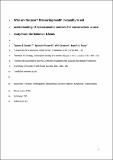Files in this item
Who are the poor? Measuring wealth inequality to aid understanding of socioeconomic contexts for conservation : a case study from the Solomon Islands
Item metadata
| dc.contributor.author | Davies, Tamara Ellen | |
| dc.contributor.author | Pettorelli, Nathalie | |
| dc.contributor.author | Cresswell, Will | |
| dc.contributor.author | Fazey, Ioan R.A. | |
| dc.date.accessioned | 2015-06-04T10:10:03Z | |
| dc.date.available | 2015-06-04T10:10:03Z | |
| dc.date.issued | 2014-12 | |
| dc.identifier | 118992463 | |
| dc.identifier | b2b52dcf-45c2-41be-8e74-be687cfb26f3 | |
| dc.identifier | 84908892667 | |
| dc.identifier | 000344540500007 | |
| dc.identifier.citation | Davies , T E , Pettorelli , N , Cresswell , W & Fazey , I R A 2014 , ' Who are the poor? Measuring wealth inequality to aid understanding of socioeconomic contexts for conservation : a case study from the Solomon Islands ' , Environmental Conservation , vol. 41 , no. 4 , pp. 357-366 . https://doi.org/10.1017/S0376892914000058 | en |
| dc.identifier.issn | 0376-8929 | |
| dc.identifier.other | ORCID: /0000-0002-4684-7624/work/60426914 | |
| dc.identifier.uri | https://hdl.handle.net/10023/6748 | |
| dc.description | TD was supported by a Natural Environment Research Council studentship (DTG: AGS6-NERC10). Additional funding for fieldwork was provided by Chester Zoo and Rufford Small Grants (11022-1) Date of Acceptance: 30/01/2014 | en |
| dc.description.abstract | Understanding the local socioeconomic context is important for the design of appropriate conservation initiatives and associated monitoring strategies, especially in areas with high degrees of inequality, to ensure conservation interventions do not inadvertently further disadvantage vulnerable people. Typical assessments of wealth inequality in remote rural areas are constrained by limited engagement with a cash economy, complex family and tribal ties, and an absence of basic infrastructure. This paper presents a simple participatory approach to measure wealth inequality that does not predefine indicators, such as income or assets, but allows the local people choose the most appropriate indicators. A case study from the Solomon Islands revealed poor households in Kahua were characterized by fewer members, fewer members of working age, and fewer male members than wealthier households. The poor also owned fewer of the locally defined indicators of wealth that were collectively correlated with limited land tenure, and, consequently, conservation or development initiatives that are tied to land in Kahua will be less likely to assist the poorest. Adopting this participatory approach could improve the effectiveness of community-based conservation, through facilitating opportunities to explore local poverty and routes for alleviation. | |
| dc.format.extent | 633098 | |
| dc.language.iso | eng | |
| dc.relation.ispartof | Environmental Conservation | en |
| dc.subject | Poverty | en |
| dc.subject | Participatory | en |
| dc.subject | Monitoring | en |
| dc.subject | Solomon Islands | en |
| dc.subject | Melanesia | en |
| dc.subject | Conservation | en |
| dc.subject | QH301 Biology | en |
| dc.subject | G Geography (General) | en |
| dc.subject | SDG 15 - Life on Land | en |
| dc.subject.lcc | QH301 | en |
| dc.subject.lcc | G1 | en |
| dc.title | Who are the poor? Measuring wealth inequality to aid understanding of socioeconomic contexts for conservation : a case study from the Solomon Islands | en |
| dc.type | Journal article | en |
| dc.contributor.institution | University of St Andrews. Geography & Sustainable Development | en |
| dc.contributor.institution | University of St Andrews. School of Biology | en |
| dc.contributor.institution | University of St Andrews. Scottish Oceans Institute | en |
| dc.contributor.institution | University of St Andrews. Institute of Behavioural and Neural Sciences | en |
| dc.contributor.institution | University of St Andrews. St Andrews Sustainability Institute | en |
| dc.contributor.institution | University of St Andrews. Centre for Biological Diversity | en |
| dc.identifier.doi | https://doi.org/10.1017/S0376892914000058 | |
| dc.description.status | Peer reviewed | en |
This item appears in the following Collection(s)
Items in the St Andrews Research Repository are protected by copyright, with all rights reserved, unless otherwise indicated.

